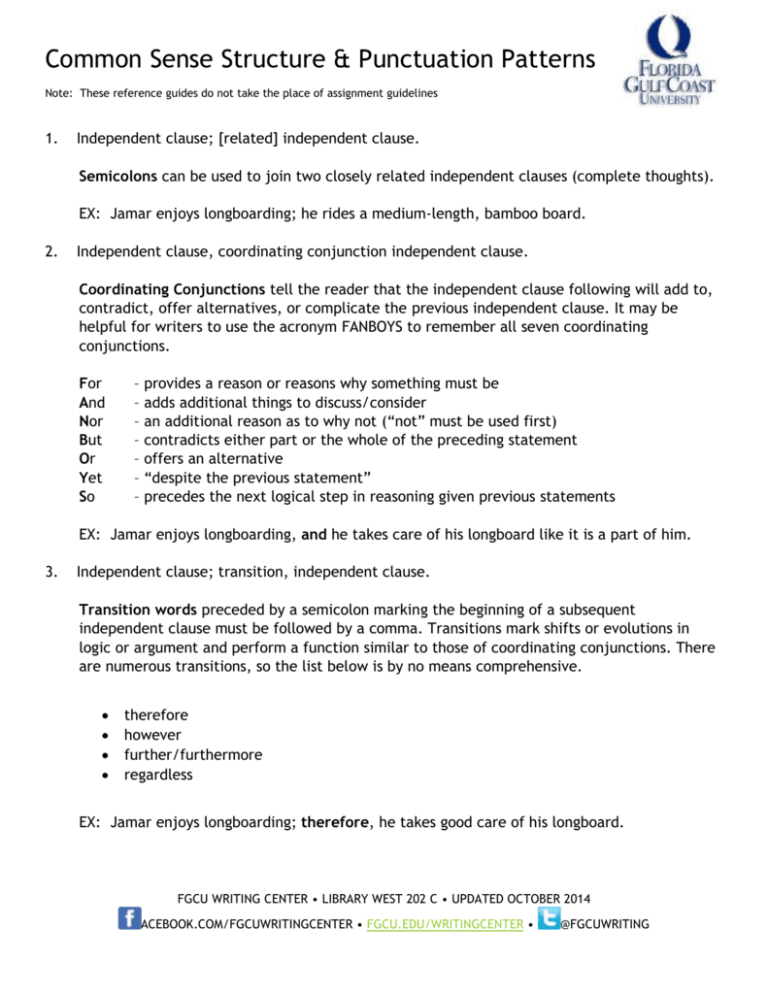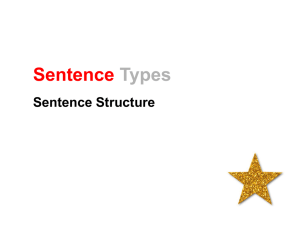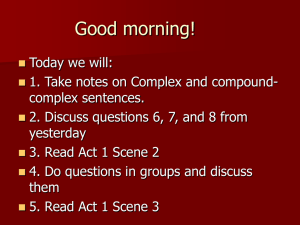Common Sense Structure and Punctuation Rules
advertisement

Common Sense Structure & Punctuation Patterns Note: These reference guides do not take the place of assignment guidelines 1. Independent clause; [related] independent clause. Semicolons can be used to join two closely related independent clauses (complete thoughts). EX: Jamar enjoys longboarding; he rides a medium-length, bamboo board. 2. Independent clause, coordinating conjunction independent clause. Coordinating Conjunctions tell the reader that the independent clause following will add to, contradict, offer alternatives, or complicate the previous independent clause. It may be helpful for writers to use the acronym FANBOYS to remember all seven coordinating conjunctions. For And Nor But Or Yet So – – – – – – – provides a reason or reasons why something must be adds additional things to discuss/consider an additional reason as to why not (“not” must be used first) contradicts either part or the whole of the preceding statement offers an alternative “despite the previous statement” precedes the next logical step in reasoning given previous statements EX: Jamar enjoys longboarding, and he takes care of his longboard like it is a part of him. 3. Independent clause; transition, independent clause. Transition words preceded by a semicolon marking the beginning of a subsequent independent clause must be followed by a comma. Transitions mark shifts or evolutions in logic or argument and perform a function similar to those of coordinating conjunctions. There are numerous transitions, so the list below is by no means comprehensive. therefore however further/furthermore regardless EX: Jamar enjoys longboarding; therefore, he takes good care of his longboard. FGCU WRITING CENTER • LIBRARY WEST 202 C • UPDATED OCTOBER 2014 ACEBOOK.COM/FGCUWRITINGCENTER • FGCU.EDU/WRITINGCENTER • @FGCUWRITING Common Sense Structure & Punctuation Patterns Note: These reference guides do not take the place of assignment guidelines 4. Dependent clause or phrase, subordinating conjunction independent clause. Commas can serve, among other functions, to separate dependent clauses (incomplete or unfinished thoughts containing at least a subject and a verb) or phrases (incomplete thoughts containing at least a verb but no subject) from independent clauses. Subordinating conjunctions signal a dependent clause or phrase; these conjunctions create a condition or incomplete thought that requires an additional independent clause to finish or fulfill. A few subordinating conjunctions are listed below. while although if when before after since EX: While he was longboarding around town, Jamar found a new coffee shop. EX: Before buying a coffee, he inspected the pastries. 5. Independent clause subordinating conjunction dependent clause or phrase. Independent clauses and dependent clauses do not need commas to glue them together when the independent clause comes first and is followed by a subordinating conjunction. Jamar longboarded around town until he found a new coffee shop. 6. Participial phrase, independent clause. Participial phrases that begin with a participle (a form of a verb) are a type of dependent phrase and modify the subject of the sentence. Unlike independent clauses containing a participle, participial phrases do not contain a subject. Pumping as hard as he could, Jamar seemed to fly over the street on his longboard. 7. Independent clause, participial phrase. Jamar longboarded around town, searching for a good hill to ride down. FGCU WRITING CENTER • LIBRARY WEST 202 C • UPDATED OCTOBER 2014 ACEBOOK.COM/FGCUWRITINGCENTER • FGCU.EDU/WRITINGCENTER • @FGCUWRITING







